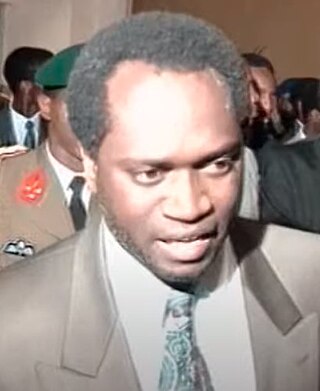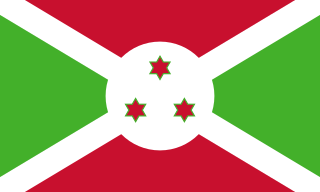The term "minority group" has different usages, depending on the context. According to its common usage, the term minority group can simply be understood in terms of demographic sizes within a population: i.e. a group in society with the least number of individuals, or less than half, is a "minority’. Usually a minority group is disempowered relative to the majority, and that characteristic lends itself to different applications of the term minority.

Melchior Ndadaye was a Burundian banker and politician who became the first democratically elected and first Hutu president of Burundi after winning the landmark 1993 election. Though he attempted to smooth the country's bitter ethnic divide, his reforms antagonised soldiers in the Tutsi-dominated army, and he was assassinated amidst a failed military coup in October 1993, after only three months in office. His assassination sparked an array of brutal tit-for-tat massacres between the Tutsi and Hutu ethnic groups, and ultimately led to the decade-long Burundi Civil War.

Sylvie Kinigi is a Burundian politician and economist who served as prime minister of Burundi from 10 July 1993 to 7 February 1994, and acting president from November 1993 to 5 February 1994, making her the second African woman to serve as a president.

The culture of Burundi is based on local tradition and common influence with its neighbors.

Mass killings of Tutsis were conducted by the majority-Hutu populace in Burundi from 21 October to December 1993, under an eruption of ethnic animosity and riots following the assassination of Burundian President Melchior Ndadaye in an attempted coup d'état. The massacres took place in all provinces apart from Makamba and Bururi, and were primarily undertaken by Hutu peasants. At many points throughout, Tutsis took vengeance and initiated massacres in response.

The Algeria women's national football team represents Algeria in international women's football.

In many countries, women have been underrepresented in the government and different institutions. This historical tendency still persists, although women are increasingly being elected to be heads of state and government.

Women in Nigeria are a diverse group of individuals who have a wide range of experiences and backgrounds. They are mothers, daughters, sisters, wives, entrepreneurs, professionals, and activists. Women in Nigeria face numerous challenges, including gender inequality, poverty, and a lack of access to education and healthcare. Despite these challenges, Nigerian women are making strides in all areas of life and are becoming increasingly empowered to take control of their lives and their futures.

The Burundi women's national football team, nicknamed the Swallows, represents Burundi in women's international football competitions. The team has competed since 2016 in matches recognised by FIFA, the sport's international governing body. A senior national team has been continually inactive, but an under-20 team has played in numerous matches. Further development of football in the country faces challenges found across Africa, including inequality and limited access to education for women. A women's football programme did not exist in Burundi until 2000, and only 455 players had registered for participation on the national level by 2006.

The Rwanda women's national football team represents Rwanda in women's association football and is controlled by the Rwandese Association Football Federation. It had to date been scheduled to compete in one major tournament, the inaugural Women's Challenge Cup held in Zanzibar in October 2007, but the event was ultimately canceled. It has finally debuted in February 2014 against Kenya. The team is nicknamed The She-Amavubi.

The Czech Republic provides a wide variety of civil rights to female citizens and Czech women have a long history of actively participating in Czech society. However, women in the Czech Republic continue to experience gender discrimination, particularly in the workforce and political arena.

The culture, evolution, and history of women who were born in, live in, and are from the continent of Africa reflect the evolution and history of the African continent itself.

Burundian nationality law is regulated by the Constitution of Burundi, as amended; the Nationality Code of Burundi, and its revisions; and various international agreements to which the country is a signatory. These laws determine who is, or is eligible to be, a national of Burundi. The legal means to acquire nationality, formal legal membership in a nation, differ from the domestic relationship of rights and obligations between a national and the nation, known as citizenship. Burundian nationality is typically obtained under the principle of jus sanguinis, i.e. by birth in Burundi or abroad to parents with Burundian nationality. It can be granted to persons with an affiliation to the country, or to a permanent resident who has lived in the country for a given period of time through naturalization.
Isha Tejan-Cole Johansen is a Sierra Leonean entrepreneur and the former president of the Sierra Leone Football Association. Johansen is one of only a few women in the world to have headed a national football association, along with Lydia Nsekera, the former president of the Burundi football association, Izetta Sombo Wesley, the former leader of the Liberia Football Association and Sonia Bien-Aime of the Turks and Caicos Islands Football Association.
Feminist institutionalism is a new institutionalist approach that looks at how gender norms operate within institutions and how institutional processes construct and maintain gender power dynamics. Feminist institutionalism focuses on how institutions are gendered and how their formal and informal rules play a part in shaping political life. It offers a new way of interpreting the formation of institutions that goes beyond traditional views by accounting for the gendered stigma and gendered outcomes that comes with institutions. As a result, feminist institutionalism is changing the face of various institutions by providing awareness into their very own dynamics of inclusion and exclusion.
Clotilde Niragira was a Burundian politician and lawyer. She served as head of three separate ministries in Pierre Nkurunziza's government and was Secretary-General of Burundi's Truth and Reconciliation Commission.

On 21 October 1993, a coup was attempted in Burundi by a Tutsi–dominated army faction. The coup attempt resulted in assassination of Hutu President Melchior Ndadaye and the deaths of other officials in the constitutional line of presidential succession. François Ngeze was presented as the new President of Burundi by the army, but the coup failed under domestic and international pressure, leaving Prime Minister Sylvie Kinigi in charge of the government.
Susan Franceschet is a Canadian political scientist. She is a professor of political science at The University of Calgary. She studies the representation of women both in legislatures and government cabinets, gender quotas for the minimum representation of women in government, and the interaction of gender and public policy. She has written about women's participation in the politics of Chile.
Gender parity is a statistical measure used to describe ratios between men and women, or boys and girls, in a given population. Gender parity may refer to the proportionate representation of men and women in a given group, also referred to as sex ratio, or it may mean the ratio between any quantifiable indicator among men against the same indicator among women.
A gender quota is a tool used by countries and parties to increase women's representation in legislature. Women are largely underrepresented in parliaments and account for a 25.8% average in parliaments globally. As of November 2021, gender quotas have been adopted in 132 countries. Around the world, quotas vary greatly in their enforcement and the stage of electoral process targeted, creating three main types of quotas: legislated candidate quotas, voluntary party quotas, and reserved seats. Regardless of their prevalence, they are a controversial measure, creating debates concerning their impacts, both negative and positive.













